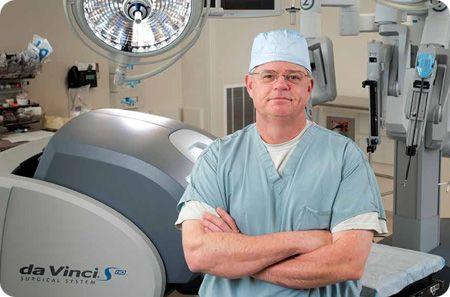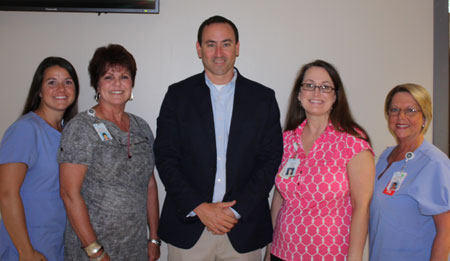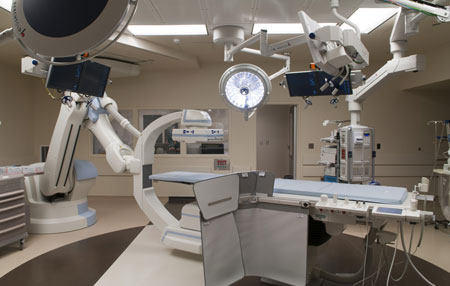Inside the Operating Room with Dr. Clifton Lewis for a Robotic Mitral Valve Repair & More
By Adam Pick on September 30, 2013
I just experienced something extraordinary.
After putting on scrubs, a cap and a surgical mask, I went inside a cardiac operating room to observe a robotic mitral valve repair surgery. This high-tech procedure was performed by Dr. Clifton Lewis at Princeton Baptist Medical Center in Birmingham, Alabama. If you didn’t know, Dr. Lewis is a minimally invasive specialist that has performed over 8,500 cardiac procedures of which more than 3,500 involved valve repairs or valve replacements.
Needless to say, this experience was… very interesting. On one hand, the patient (who suffered from severe mitral regurgitation due to mitral valve prolapse) did incredibly well. The post-operative echo showed no mitral valve leakage following the procedure. On the other hand, I witnessed first-hand how the million dollar robot enabled Dr. Lewis to reconstruct a mitral valve using an annuloplasty ring and a synthetic chordae — from a remote control panel that was 5 feet away from the operating table.
To share this experience with you, I created this video.
“The robot is really just another surgical instrument,” Dr. Lewis shared with me, “It is under the control of myself and Richard, my physician assistant, who is positioned next to the operating table.” Thus far, Doctor Lewis has performed over 700 robotic mitral valve procedures. He has also used the robot for tricuspid valve repair procedures as well.

“In my opinion, there are several advantages that the robot offers patients,” Dr. Lewis noted, “The patients recover faster, there is less bleeding, reduced infection risk and it’s more cosmetically appealing as our incisions are typically no greater than two centimeters.”
After the mitral valve repair procedure, I was fortunate to tour the Princeton Baptist Medical Center — which was quite impressive. Last October, Princeton Baptist completed a $57 million expansion which included 90,000 square feet of space including a state of the art Surgical Center. I was also able to see its new hybrid operating suite that will be used to support the launch of its transcatheter aortic valve replacement (TAVR) program when its new valve clinic launches in the very near future.
“Princeton Baptist is dedicated to helping patients with valvular disease,” stated Claudia Wilkey, the director of the heart valve clinic, who has been with the health system for over 40 years. “Although our hybrid operating suite is ready to go, we are making sure the right processes are in place to support an effective TAVR program.”


Later in the afternoon, I went back to the surgical center to check in on Dr. Lewis. There, in operating room #13, Dr. Lewis was performing a minimally invasive, aortic valve replacement for a patient who had a severely calcified valve.
This was Dr. Lewis’ fourth of five procedures during this very busy day.
“I am addicted to this work,” Dr. Lewis shared with me. “Since I was 14 years old, I knew this is what I wanted to do with my life.”
Many thanks to Dr. Clifton Lewis and the entire team at Princeton Baptist Medical Center for providing me such a great opportunity to learn more about their center in Birmingham.
Keep on tickin!
Adam
P.S. Here is a written transcript of the video with Dr. Lewis:
Adam Pick: I’m thrilled to be here today with Dr. Clifton Lewis. We’re at Princeton Baptist Medical Center at Birmingham, Alabama and we’re just getting ready to see a mitral valve procedure being performed. Dr. Lewis maybe you could tell us a little bit about the operation that’s about to occur.
Dr. Clifton Lewis: Be happy to. What we’re going to do is we’re going to do a robotic mitral valve repair on a young man who’s in his 20’s. And, he has developed severe mitral valve insufficiency related to mitral valve prolapse. So the idea is we want to repair the valves so we can get rid of the leak so that he does not have heart failure and he’s not limited. The typical approach to mitral valve repair is the sternal incision or breastbone incision. Now, for us, our typical approach is thru the right chest. The robot will make 5 little holes on the right breast. And the reason that we use that approach is the advantage. So when we use a robot, we operate thru small ports, the biggest one is about 2 centimeters in length and that allows a speedy recovery. You can be back to normal activities in 2 weeks, and you bleed less, it’s cosmetically better and the risk of infection is lower. But for us, the number one reason we like it is our odds of getting the mitral valve repair are higher than if we go thru the sternum. Our repair rates for isolated mitral insufficiency thru the right side are 95% plus. Nationwide, mitral valve repair rates are somewhere around 45 to 50%. And in the operating room, the number one thing the surgeon can do to help the patient with this problem, mitral valve leakage, is to repair the valve.
Adam Pick: Why is it that the repair is so important compared to replacements?
Dr. Clifton Lewis: Well there are a couple of reasons. One, if you repair a valve, you do not have to be on coumadin, like you do for, say a mechanical valve. This young man at his age, we would need to put him in mechanical valve which would lock him to coumadin for the rest of his life. The other, and I think the more compelling reason is that there is a survival advantage of repair over replacement. If you look at hospital results, 5-year results, 20-year results, the odds of being alive look better with valve repair than replace.
Adam Pick: So now, we’re out of the procedure and Dr. Lewis, we’re curious to know what you thought on how it went inside Operating room 13?
Dr. Clifton Lewis: Well you know, actually this was a fairly complex mitral valve repair. He had a lot of valve calcification. But one of the nice things about a robot, you can work your way around those problem. So, ultimately we were able to repair it. What we did is we’ve put one new chordae tendinae, the little supporting tethering strings that are on the mitral valve. We put in an annuloplasty band and we closed 2 clefts of the posterior leaflet. And when we got done, our echocardiogram showed that we went from wide open mitral insufficiency to none. We were really pleased with our repair.
Adam Pick: Well Dr. Lewis, on behalf of this patient and all the patients that we knew you’ve helped in our community, I just want to thank you for all your great work here at Princeton Baptist Medical Center in Birmingham, Alabama.
Dr. Lewis: Thank you very much. I appreciate it. Thanks for coming to visit.













